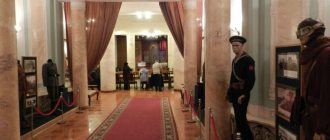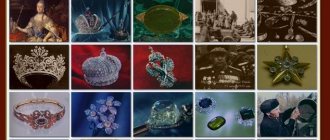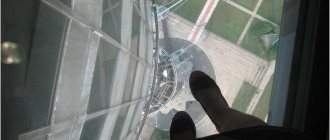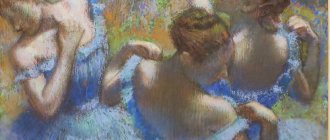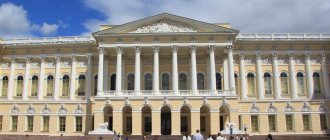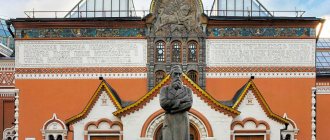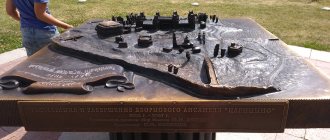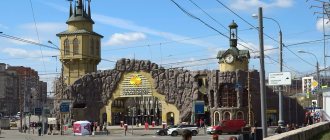Opening hours of the Pushkin Museum of Fine Arts in 2021
Main building
- Tuesday, Wednesday, Saturday and Sunday 11:00 to 20:00
- Thursday and Friday from 11:00 to 21:00
- Monday - closed
- Box office closes an hour earlier
Gallery of Art of Europe and America of the 19th-20th centuries
- Tuesday, Wednesday, Saturday and Sunday from 11:00 to 20:00
- Thursday and Friday - from 11:00 to 21:00
- Monday - closed
- Box office closes an hour earlier
Museum of Personal Collections (temporary exhibitions)
- The main exhibition is closed until 2023.
Farewell to the poet
In Hall No. 15 you can get acquainted with the final years of the poet’s life. Pushkin's manuscripts, books, personal belongings and documents of recent years are exhibited within its walls. Here hang portraits of people from the inner circle, handwritten copies of the last poems and a tragic death mask.
The majestic “Anteroom” completes the excursion through the Pushkin era and is dedicated to the memory of the early departed poet. It houses a beautiful grandfather clock made in the 19th century, and next to it is a copy of the monument to the poet by Alexander Mikhailovich Opekushin.
Ticket prices for the Pushkin Museum of Fine Arts in 2021
Main building
- For adults - 500 rubles
- For children under 6 years old inclusive - free
- For children from 7 to 18 years old - 250 rubles
- For Russian students - 250 rubles
- For citizens of the Russian Federation from 18 to 24 years old inclusive - 250 rubles
- For citizens of the Russian Federation 60 years and older - 250 rubles
Gallery of Art from Europe and America of the 19th–20th centuries
- For adults - 500 rubles
- For children under 6 years old inclusive - free
- For children from 7 to 18 years old - 250 rubles
- For Russian students - 250 rubles
- For citizens of the Russian Federation from 18 to 24 years old inclusive - 250 rubles
- For citizens of the Russian Federation 60 years and older - 250 rubles
Vyazema Estate
House-palace of the Vyazemy estate
Beautiful palace and park in the Moscow region
called the poet's poetic homeland. Just a few kilometers from here, in the small village of Zakharovo, Pushkin spent his childhood. Here he first saw the beauty of Russian nature, was able to admire peasant round dances, heard folk songs and became acquainted with the life, customs and daily life of the provincial nobility of Russia.
Today, both estates have the status of a museum-reserve. On the territory of the memorial complex there are more than 20 historical monuments - a palace with outbuildings, ancient ponds, a belfry of the 16th century, the Transfiguration Church and luxurious parks. In the restored house of Pushkin’s grandmother, Maria Alekseevna Hannibal, a museum dedicated to the poet’s childhood has been opened.
How to get to the Pushkin Museum of Fine Arts
Address: Moscow, Volkhonka st., 12.
The nearest metro station is Kropotkinskaya. The museum is located on the opposite side of the Cathedral of Christ the Savior. The museum includes three buildings: the main building, the Gallery of European and American Art of the 19th-20th centuries. and the building of the museum of personal collections. Since the first place on the way from the metro is the Gallery, the sign of which also says that this is the Pushkin Museum, you don’t have to get to the main building and walk around the Gallery. Sometimes there is a queue at the ticket office of the Main building, which can become a landmark for the entrance to the Museum.
Fairytale world
Another permanent exhibition is called “Pushkin's Tales”. It is very small and occupies only two rooms on the first floor. Excursions are conducted here for preschoolers and elementary school students, and parents with children are happy to come here.
Hall No. 11. “The Bronze Horseman”
The first room contains tools, peasant household items and ancient paintings. Here you can also see illustrations for Pushkin’s fairy tales made by famous Russian artists - Vladimir Mikhailovich Konashevich, Vladimir Alekseevich Milashevsky and Tatyana Alekseevna Mavrina. Another room represents the magical “Buyan Island” - a fairy-tale world intended for children's games.
Story
In 1893, Moscow State University professor, doctor of Roman literature and historian Ivan Vladimirovich Tsvetaev conceived the idea of creating a museum as a textbook on art history - with copies of ancient antique vases, sculptures and other objects. In 1898, its foundation ceremony took place. A significant portion of the money for the construction was contributed by philanthropist Yuri Stepanovich Nechaev-Maltsev. The design competition was won by the self-taught architect P.S. Fighters. The construction was supervised by architect R.I. Klein. Architects I.I. took part in the construction. Rerberg and V.G. Shukhov, as well as many talented masters of that time. The internal layout and plan of the building were created in accordance with the ideas of P.S. Boytsova. And the interiors and facades are the work of R.I. Klein and his assistants.
On May 31, 1912, the Museum of Fine Arts named after Emperor Alexander III was opened. Its first director in 1912–1913 was its founder Ivan Vladimirovich Tsvetaev. In 1932, the museum was renamed the State Museum of Fine Arts, and in 1937 it was named after A.S. Pushkin. During the Great Patriotic War, the exhibits themselves were evacuated to Novosibirsk and Solikamsk. The building, including its glass roofs, was damaged by bombing. After the war, in October 1946, when the building was restored, the opening of the exhibition took place. Since 1980, on the initiative of Svyatoslav Richter and the director of the Pushkin Museum I.A. Antonova hosts the annual music and painting festival “December Evenings”.
In 1985, the Museum of Personal Collections was founded as the scientific department of the Pushkin Museum, designed to preserve the “spiritual connection” between the collection and its former owner. The Pushkin Museum's exhibits are currently being digitized. Passports are created for all exhibits, which are necessary for registration, storage and restoration. The high quality of the electronic copy allows you to record and control the condition of the exhibit, the location and depth of microcracks. In case of restoration it will be possible to restore the item.
Antique temple
Article on the topic
There was an imperial palace here, then a prison. How the Pushkin Museum was created 100 years ago. Pushkin The building was designed like a huge ancient temple, which corresponded to its purpose: it was originally intended that the second collection of originals and casts of Greek sculpture in Russia after the Hermitage would be housed here. Tsvetaev understood that without understanding ancient art it is impossible to understand European art, which is its continuation. Plaster casts and other copies have been ordered since the 1890s from foreign workshops using molds taken directly from the originals. In some cases, copies were made for the first time.
The museum was named in honor of Emperor Alexander III and immediately after its opening it gained enormous popularity: on weekdays it was visited by 700–800 people, and on Sundays and holidays - up to two and a half thousand - numbers unheard of at that time. Among the visitors were mostly teachers and students of gymnasiums and universities, Higher Women's Courses, and artists.
Pushkin Museum im. Pushkin. Photo: RIA Novosti / Yuri Abramochkin
Pushkin Museum - exhibits
The collection of the Pushkin Museum contains works by Western masters from antiquity to the 20th century. Each of the halls is dedicated to a specific era. The entire collection contains about 670 thousand works of exhibits, but only 1.5% of the funds are available to the general public. The ground floor mainly houses antiquities. The Egyptian Hall is located here. Also presented are objects of ancient peoples who inhabited Western Asia and the Mediterranean, the Indian Peninsula and Latin America. One of the most unique exhibits is a unique treasure discovered by the German archaeologist Heinrich Schliemann during his excavations in Troy in 1871–1890. This treasure was considered lost during World War II. It later turned out that, along with other trophies, it was taken from Germany to the Soviet Union and was kept in the strictest secrecy in the storerooms of the Pushkin Museum.
The halls on the second floor display more than a thousand exhibits from ancient Greece and Rome. These are antique amphorae and ceramics, sculpture. Here are copies of the most famous sculptures of antiquity. Visitors will see items from the Middle Ages and the Renaissance. Works by 19th and 20th century masters are on display, as well as a large collection of French Impressionist and Post-Impressionist artists, including works by famous artists such as Matisse and Picasso, Gauguin and Van Gogh. The collection of Byzantine icons occupies a special place. You can see works by European masters such as Cranach, Botticelli, Poussin and David. The pearls of the collection are the icons “Madonna and Child Enthroned” and “Madonna and Child and Two Donors”. Many of the items ended up in the Moscow State Institute of Fine Arts after the Great Patriotic War, including those from the Dresden Gallery. The Northern Renaissance is presented in the room entitled "Art of Germany and the Netherlands of the 15th and 16th centuries." Works by Rembrandt and his students are displayed in the hotel exhibition. Dutch school of the 17th century. The “Italian Courtyard” and “Greek Courtyard” halls are especially popular. The "Greek Courtyard" has a three-level floor that conveys the architecture of the Athenian Acropolis. And the “Italian Courtyard” hall repeats the courtyard of Palazzo Bargelo with a corner staircase and small columns supporting a balcony, a light arcade and a well in the center. At the Pushkin Museum, many exhibits are not taken out of the storerooms, since there are standards according to which the placement and storage of exhibits is determined. The museum exhibition is constantly changing, since all exhibits cannot be displayed to visitors at the same time. There are also exhibitions of masterpieces from the world's largest art galleries.
Impressionist exhibition
The stock of the Impressionist Hall in the Pushkin Museum includes works by internationally recognized masters, including Picasso, Monet, Cezanne. Impressionism appeared in France as a response to primitivism and abstractionism. Both in terms of color scheme and technique, the works of masters of this direction are distinguished by amazing diversity, but the main thing that unites them is the originality of each canvas, the personality of the artist, addressed to the viewer through the language of colors and shadows.
The museum's collection contains paintings that constitute the heritage of world painting. Some of them need to be mentioned separately.
"Girl on a Ball", Pablo Picasso
Pablo Picasso “Girl on a Ball”
Pablo Picasso’s canvas “Girl on a Ball” (1905) personifies the contrast of statics and dynamics, dull reality and inner life full of movement. A fragile performer of a traveling circus, bending and raising her arms up, rehearses her act, balancing on a gray ball. She looks down, trying to guess the trajectory of the object, and smiles.
An athlete sits on a cube right in front of her. Through the tight-fitting T-shirt, you can see the outline of the back muscles. With his static posture, the firmness of his stance and the strength of his muscular body, he resembles a statue. The figure of the athlete fits harmoniously into the gloomy nature depicted in the picture, framed by monotonous hills and a gray, nondescript sky. And only the fragile girl stands out from this rural landscape. She could fly up, but she is unable to resist the force of gravity, and all she can do here is balance on the ball.
"Red Fishes", Henri Matisse
"Red Fishes", Henri Matisse
Another amazing example of impressionist art is Henri Matisse’s painting “Red Fishes”: goldfish, bright and fragile, are placed in the cramped space of a cylindrical vessel. Compared to the flower pots on the table, they seem disproportionately large.
The painter follows the principle of reverse perspective: violating the laws of proportions, the artist brings to the fore the most important objects in the composition. Matisse borrowed this approach from the techniques of icon painting and Persian miniatures. Red color symbolizes life, movement, beauty. The idea of vitality is emphasized by the greenery that frames the aquarium—the leaves of flowers and plants. This is one of the most optimistic paintings of the Impressionist heritage.
"The Poor Fisherman", Pierre Puvis de Chavannes
The work of Pierre Puvis de Chavannes “The Poor Fisherman” makes a different impression on the viewer. An old boat is parked on the river bank. A fisherman stands in it with his arms crossed on his stomach. His head is tilted, his face is not visible. He feels sad in his soul, some heavy thoughts torment his lonely heart. Although he is not alone—behind him on the shore are two orphans, a boy and a baby—he no longer has a single close soul in this world.
Pierre Puvis de Chavannes "The Poor Fisherman"
The entire canvas is permeated by the idea of disunity - all 3 characters in the picture are at a distance from each other. They are related by family ties, but there is no love between them. In the black rags of the son, in the obscene nakedness of the baby abandoned on the ground, in the father who turned away from them and went deep into himself, one can see the trace that bereavement left on their destinies. The predominance of gray-yellow shades on the canvas symbolizes hopelessness and deep melancholy.
"Breakfast on the Grass", Claude Monet
Claude Monet "Luncheon on the Grass"
Claude Monet's painting "Lunch on the Grass" is a kind of dialogue with the same name and somewhat provocative painting by Edouard Manet (kept in Paris). The canvas by Claude Monet shows the leisure of an aristocratically educated society: elegantly dressed men and women relax peacefully in nature. Plates, glasses, bottles of wine, cakes and snacks are placed on a snow-white tablecloth.
The ladies are talking peacefully, a young man is leaning against a tree, resting, another is thoughtfully smoking a pipe... A typical rest of a noble society. Nothing here speaks of passion or strong feelings.
One can imagine that nothing unusual can happen here, but the picture is given some piquancy by the heart and the letter P scratched on the birch trunk (Pierre? Pauline?), as well as the lonely figure of a man in a top hat. Among the cheerful, relaxed feast, he gives the impression of a hermit, jealously observing the lives of others. He hid behind a tree trunk, no one notices him, but he turned his head and listened carefully to other people's conversations.
"Red Vineyards in Arles", Vincent Van Gogh
"Red Vineyards in Arles", Vincent Van Gogh
Hardworking peasants, bending over bushes of ripe grapes, carefully pick ripe bunches. Women wear simple long skirts, linen shirts, and scarves. In the distance their houses are visible, which they left early in the morning. This is the south of France, Provence - a place famous for its vineyards and lavender fields. Van Gogh lived here for only a few months in 1888, but here, 2 years before his death, he found inspiration for creating his best works - “Sunflowers”, “Night Cafe” and “Red Vineyards”.
The canvas is painted with large strokes, which creates a feeling of merging contours (impasto technique). People and the field on which they work are a single whole. In the master’s masterpiece we see peasants at the height of the working day, when the round, clearly defined disk of the sun mercilessly scorches and dries the earth, grass, and grape leaves. There is almost no green here. Yellow sky, yellow field, yellow road - and only red vineyards and blue figures of trees and people.
The painting was brought to Russia by Russian businessman and collector I.A. Morozov. After nationalization in 1923, the painting ended up in a museum.
“Are You Jealous”, Paul Gauguin
“Are You Jealous” Paul Gauguin
Two young women sat on the river bank under the scorching heat. A pleasant languor pervades their strong naked bodies. They think, talk and dream about only one thing - love. One of the women turns to the other and asks: “Are you jealous?”
Paul Gauguin considered this painting one of his best works. As in most other Tahitian paintings by the master, warm colors predominate in it and there is practically no shadow. The sun is high above the earth. It's a hot summer day, but Tahitian women are not afraid of the sun and are not ashamed of nakedness. They are children of nature, part of it. The red colors of women's skirts contrast with the green foliage of the tree, which emphasizes the passion, energy of women, their love for life and pleasures.
Gauguin painted the canvas in 1892 and 3 years later sold it at a sale in Paris for 500 francs (about 20 dollars, 40 rubles at the exchange rate of the early twentieth century). In 1908, the work was purchased and brought to Moscow by collector S.I. Shchukin, and after the revolution it came first to the State Museum of Historical Art, then to the Pushkin Museum of Fine Arts. Pushkin.
Museum of Fine Arts named after A.S. Pushkin - information for tourists
The divisions of the Pushkin Museum are the Educational Art Museum named after I.V. Tsvetaeva and Memorial Apartment of Svyatoslav Richter. The Museion Center for Aesthetic Education of Children and Youth has been created, which organizes exhibitions and meetings with artists, performances and musical concerts. State Museum of Fine Arts named after A.S. Pushkin offers lectures, excursions and study groups. More than 15 different routes have been developed that allow you to view exhibits created by masters of various historical periods. Excursions with a guide in Russian and foreign languages are organized for visitors. For convenience, it is possible to present transport services - cars and buses. Audio guide services are available. Excursions to the Museum of Fine Arts named after A.S. Pushkin can be booked.
First of its kind
Moscow museums of the second half of the 19th century were not like modern galleries. Firstly, most often these were private collections, limited by the budget and tastes of their owners. Secondly, they were usually located in premises that were not originally built to host exhibitions, and were not always well suited for this. And thirdly, entry to the exhibitions was not open to everyone: the first fully public art museum in Russia was opened only in 1885, and not in the capital St. Petersburg or Moscow, but in the provinces. It became the Radishchevsky Museum in Saratov, opened by the artist A.P. Bogolyubov , the grandson of the writer.
Article on the topic Marina Tsvetaeva. Life in verse
Svyatogorsk Holy Dormition Monastery
View of the Holy Assumption Cathedral
The poet’s grave and the necropolis of his closest relatives are located in the village of Pushkin Mountains, in an ancient monastery. The Christian monastery in the Pskov lands was founded in the 1560s by decree of the Russian Tsar Ivan IV the Terrible. The stone Assumption Cathedral rises on the Holy Mountain.
The ancestral necropolis is located at the apse of the monastery church. This is a modest tomb with two stone tombstones and a tablet on which are engraved the names, surnames and dates of life of the poet’s grandfather, grandmother, parents and younger brother. Pushkin himself is buried in a separate grave, under a beautiful white obelisk.
| ← RUSSIA | EUROPE → |

